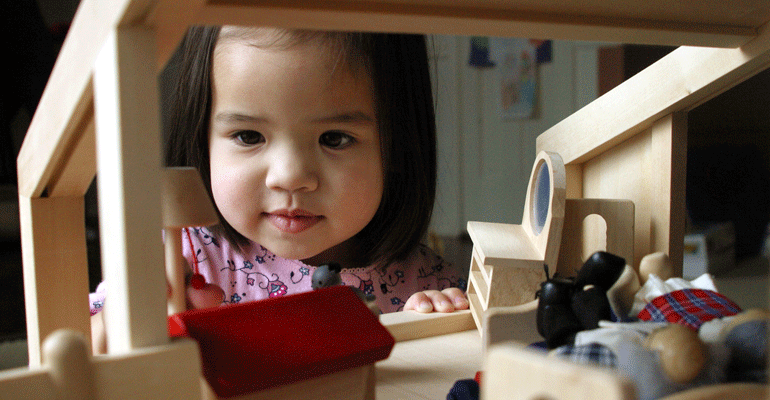I smiled and listened closely as I overheard my daughter, Lillianna, and her friend, Rachael, playing with their dolls the other day. Lilli said, “Let’s play orphanage.”
There was no hesitation. Rachael picked up the theme in a heartbeat and said, “I’ll be a mom coming to take my baby home.” And thus began an hour of play between these two adopted seven-year-olds and their dolls.
We adoptive parents have made it a practice to talk to our children about their adoption story. We retell it, discuss it from time to time, and add facts and information when it seems appropriate. There may also be times when it does not seem right to talk or encourage our children to talk about adoption, as well as times when the pressures of parenting cause us to forget about keeping up the discussion.
We find that younger children ask questions about their adoption story. As they grow older, we know they continue to think about adoption-related issues. But, ironically, as their thinking becomes more concrete, they tend to ask fewer questions and engage less in discussion about adoption.
But, as Lillianna and Rachael teach us, there is another way for adopted children to work out their feelings about adoption, and that is through play. Playing is comfortable, natural, and more fun than talking. And, lucky and fun for us, we can be a big part of it.
Barbie’s Home Study
This realization came to me one day when Lilli asked me to play Barbie with her. I had never been a big fan of Barbie and her friends (although I would have to concede that they now come in plenty of great colors). On this day, I decided to put my own agenda into the mix to make it interesting for me.
Accordingly, I suggested to Lilli that Barbie and Ken wanted to adopt a baby from China. Usually Lilli doesn’t care for my imposing on her fantasies of dress-up, princesses, and the like. However, on that day she took my suggestion.
We played for quite awhile. Lilli took the lead in the dialogue between Barbie and Ken about adoption. I proposed that the social worker come to Ken and Barbie’s house for a home study so we could be sure that they were suitable parents. (I played the social worker.)
Barbie and Ken did quite well in the interview and seemed to have a perfect marriage. Barbie and Ken then flew to China in the pink Corvette convertible that is fashionable among Barbies. They, of course, went to an orphanage and came home with a beautiful baby.
So when I heard Lilli say to Rachael, “Let’s play orphanage,” it was music to my ears. Hearing her suggest this on her own meant that my daughter was comfortable enough to share her feelings and beliefs about adoption with her friend. It probably helped that her friend had a similar adoption story. The playing gave Lilli and Rachael another way to work out their feelings.
It has helped Lilli to understand and accept her past. Playing adoption gives me a gentle and effective way to provide my daughter with more information. Lilli now knows that families have to pass a social worker’s scrutiny to adopt. Later, I can add more bits about the adoption process and her own story, if I choose to and if she’s interested.
Many Ways to Play
I like everything about playing adoption. It is a positive way for my daughter to explore and become more comfortable about her own beginnings. You can play about adoption in general, or you can go deeper into the child’s own adoption story.
You can also probe feelings if it seems right. You can explore how it must have felt (fear of being in a new place, abandonment, coming to an adoptive family), and how it feels now. There are many levels to the play. You and your child can decide what is most comfortable. When you ask questions or suggest scenarios, the child can go with it, if she wishes. If she feels threatened by the direction the play is taking, she can say nothing, end the play, or change the story line. You’ll know what is working when you see it.
Not for Girls Only
Dolls are a perfect venue for playing out scenarios. So, what about children who don’t gravitate toward dolls? I decided to try other strategies with Tino, my son, who is eleven and does not care to discuss his adoption story very much.
LEGOs are my son’s “thing.” He plays out stories constantly with them as he builds and rebuilds. Star Wars, rescue missions, World War II battles, and current events are his realms. I entered this world one evening by asking, “Can I play LEGOs with you?” He was surprised, since I do not venture into this arena often.
“What would you want to play?” he asked.
“I was thinking of building your orphanage,” I replied. A barrage of questions ensued. How many stories would it have, did we have any baby LEGO people, would it have a roof, and what about a crib? Tino was delighted to play this with me.
Our play was part reality, as I recounted details of the day I met him, and part fantasy, as we played out a rescue mission with a LEGO car that turned into an airplane. Tino had built it specially for this event. During our time together, he learned details of his own story that I had never told him. These were minor things, but every one became important to him. At the end of our play, Tino said, “I’m just so happy I got to come home to this family.”
Our children need to accept the past so they can grow and become emotionally healthy adults. Playing adoption with them can help get them there.


